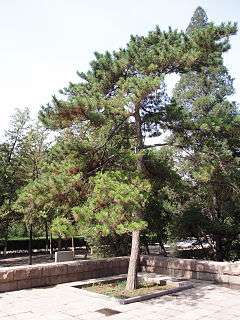Pinus tabuliformis
| Pinus tabuliformis | |
|---|---|
 | |
| Scientific classification | |
| Kingdom: | Plantae |
| Division: | Pinophyta |
| Class: | Pinopsida |
| Order: | Pinales |
| Family: | Pinaceae[2] |
| Genus: | Pinus |
| Subgenus: | Pinus |
| Species: | P. tabuliformis |
| Binomial name | |
| Pinus tabuliformis Carr. | |
Pinus tabuliformis (油松 yóusōng in Mandarin), Southern Chinese pine[3] or Chinese red pine, is a pine native to northern China from Liaoning west to Inner Mongolia and Gansu, and south to Shandong, Henan and Shaanxi, and also northern Korea. In some older texts the name is spelled "Pinus tabulaeformis".
Description
Pinus tabuliformis is a medium-sized evergreen tree 20–30 m tall, with a flat-topped crown when mature (whence the scientific name, 'table-shaped'). The growth rate is fast when young, but slows with age. The grey-brown bark fissures at an early age compared to other trees. The broadly spreading shape is very pronounced, in part due to the long horizontal branching pattern.
The needle-like leaves are shiny grey-green, 10–17 cm long and 1.5 mm broad, usually in pairs but occasionally in threes at the tips of strong shoots on young trees. The cones are green, ripening brown about 20 months after pollination, broad ovoid, 4–6 cm long, with broad scales, each scale with a small prickle. The seeds are 6–7 mm long with a 15–20 mm wing, and are wind-dispersed.
- Varieties
There are two varieties:
- Pinus tabuliformis var. tabuliformis. China, except for Liaoning. Broadest cone scales under 15 mm broad.
- Pinus tabuliformis var. mukdensis. Liaoning, North Korea. Broadest cone scales over 15 mm broad.
Some botanists also treat the closely related Henry's pine (Pinus henryi) and Sikang pine (Pinus densata) as varieties of Chinese red pine; in some older texts even the very distinct Yunnan pine (Pinus yunnanensis) is included as a variety.
Uses and cultivation
The wood is used for general construction. The pulpwood produces certain resins that are used as artificial vanilla flavouring (vanillin). The resin is also used to make turpentine and related products, and is used medicinally to treat a variety respiratory and internal ailments, such as kidney and bladder upsets, wounds, and sores. The bark is a source of tannin. Medicinal use of the pine needles also takes place, which also contain a natural insecticide, as well as a source for a dye.
It is uncommon in cultivation outside of China, grown only in botanical gardens.
References
- ↑ Farjon, A. (2011). "Pinus tabuliformis". IUCN Red List of Threatened Species. Version 2014.3. International Union for Conservation of Nature. Retrieved 15 February 2015.
- ↑ Sun, Jianghua (October 2003). "Verbenone interrupts attraction to host volatiles and reduces attack on Pinus tabuliformis (Pinaceae) by Dendroctonus valens (Coleoptera: Scolytidae) in the People's Republic of China". The Canadian Entomologist. pp. 721–732.
- ↑ "Pinus tabuliformis". Natural Resources Conservation Service PLANTS Database. USDA. Retrieved 5 Octoboer 2015. Check date values in:
|access-date=(help)
Further reading
- Conifer Specialist Group (1998). "Pinus tabuliformis". IUCN Red List of Threatened Species. Version 2006. International Union for Conservation of Nature. Retrieved 12 May 2006.
External links
| Wikimedia Commons has media related to Pinus tabuliformis. |
